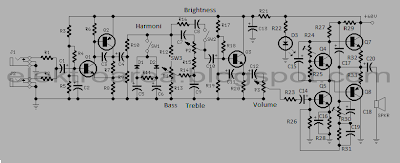In all cases where Darlington transistors are used as the output devices
it is essential that the sensing transistor (Q2) should be in as close
thermal contact with the output transistors as possible. Therefore a
TO126-case transistor type was chosen for easy bolting on the heatsink,
very close to the output pair
R30 must be trimmed in order to measure about half the voltage supply across the positive lead of C7 and ground. A better setting can be done using an oscilloscope, in order to obtain a symmetrical clipping of the output wave form at maximum output power
Note:
To set quiescent current, tide ampare meter in series between supplay with this series, then do the following
List componentR30 must be trimmed in order to measure about half the voltage supply across the positive lead of C7 and ground. A better setting can be done using an oscilloscope, in order to obtain a symmetrical clipping of the output wave form at maximum output power
Note:
To set quiescent current, tide ampare meter in series between supplay with this series, then do the following
- Set the volume control to the minimum and Trimmer R3 to its minimum resistance.
- Power-on the circuit and adjust R3 to read a current drawing of about 30 to 35mA.
- Wait about 15 minutes, watch if the current is varying and readjust if necessary.
R1,R2______________68K 1/4W Resistors
R3________________680K 1/4W Resistor
R4________________220K 1/4W Resistor
R5_________________33K 1/4W Resistor
R6,R16______________2K2 1/4W Resistors
R7__________________5K6 1/4W Resistor
R8,R21____________330R 1/4W Resistors
R9_________________47K 1/4W Resistor
R10_______________470R 1/4W Resistor
R11_________________4K7 1/4W Resistor
R12,R20____________10K 1/4W Resistors
R13_______________100R 1/4W Resistor
R14,R15____________47R 1/4W Resistors
R17,R18,R19_______100K 1/4W Resistors
R22__________________6K8 1W Resistor
R23,R25_____________470R 1/4W Resistors
R24__________________2K 1/2W Trimmer Cermet
R26,R27_______________4K7 1/2W Resistors
R28________________220R 1/2W Resistor
R29__________________2K2 1/2W Resistor
R30_________________50K 1/2W Trimmer Cermet
R31________________68K 1/4W Resistor
R32,R33______________R47 4W Wirewound Resistors
C1,C4,C5,C6________10µF 63V Electrolytic Capacitors
C2_________________47µF 63V Electrolytic Capacitor
C3_________________47pF 63V Ceramic Capacitor
C7_________________15nF 63V Polyester Capacitor
C8_________________22nF 63V Polyester Capacitor
C9________________470nF 63V Polyester Capacitor
C10,C11,C12________10µF 63V Electrolytic Capacitors
C13_______________220µF 63V Electrolytic Capacitor
C14,C15,C17,C18________47µF 63V Electrolytic Capacitors
C16________________100µF 25V Electrolytic Capacitor
C19_________________33pF 63V Ceramic Capacitor
C20_______________1000µF 50V Electrolytic Capacitor
P1,P2______________10K Potentiometers P3_________________10K Potentiometer D1,D2____________BAT46 100V 150mA Schottky-barrier Diodes D3_________________LED Q1,Q3____________BC546 NPN Transistors Q2_______________BC556 PNP Transistor Q4,Q5____________BD139 80V 1.5A NPN Transistors Q6_____________MJ11016 120V 30A NPN Darlington Transistor Q7_____________MJ11015 120V 30A PNP Darlington Transistor J1,J2___________6.3mm. Mono Jack sockets SW1,SW2___________SPST Switches SPKR______________speakers 8 or 4 Ohm with Minimum power 75W

No comments:
Post a Comment